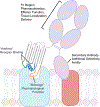Antibodies expand the scope of angiotensin receptor pharmacology
- PMID: 38744986
- PMCID: PMC11561159
- DOI: 10.1038/s41589-024-01620-6
Antibodies expand the scope of angiotensin receptor pharmacology
Abstract
G-protein-coupled receptors (GPCRs) are key regulators of human physiology and are the targets of many small-molecule research compounds and therapeutic drugs. While most of these ligands bind to their target GPCR with high affinity, selectivity is often limited at the receptor, tissue and cellular levels. Antibodies have the potential to address these limitations but their properties as GPCR ligands remain poorly characterized. Here, using protein engineering, pharmacological assays and structural studies, we develop maternally selective heavy-chain-only antibody ('nanobody') antagonists against the angiotensin II type I receptor and uncover the unusual molecular basis of their receptor antagonism. We further show that our nanobodies can simultaneously bind to angiotensin II type I receptor with specific small-molecule antagonists and demonstrate that ligand selectivity can be readily tuned. Our work illustrates that antibody fragments can exhibit rich and evolvable pharmacology, attesting to their potential as next-generation GPCR modulators.
© 2024. The Author(s), under exclusive licence to Springer Nature America, Inc.
Conflict of interest statement
Competing interests: A.C.K., C.M., L.M.W., D.P.S. and M.A.S. are co-inventors on a patent application for AT1R blocking nanobodies. A.C.K. is a cofounder and consultant for biotechnology companies Tectonic Therapeutic and Seismic Therapeutic, and also for the Institute for Protein Innovation, a nonprofit research institute. L.M.W. is a scientific advisor for Septerna. D.P.S. is a Septerna employee. C.M. is a Sanofi employee. P.B. holds patents and provisional patent applications in the field of engineered T-cell therapies and protein design. The other authors declare no competing interests.
Figures















Update of
-
Antibodies Expand the Scope of Angiotensin Receptor Pharmacology.bioRxiv [Preprint]. 2023 Aug 24:2023.08.23.554128. doi: 10.1101/2023.08.23.554128. bioRxiv. 2023. Update in: Nat Chem Biol. 2024 Dec;20(12):1577-1585. doi: 10.1038/s41589-024-01620-6. PMID: 37662341 Free PMC article. Updated. Preprint.
References
MeSH terms
Substances
Grants and funding
- R01 NS088566/NS/NINDS NIH HHS/United States
- 31003A_182263/Schweizerischer Nationalfonds zur Förderung der Wissenschaftlichen Forschung (Swiss National Science Foundation)
- R01 AI149778/AI/NIAID NIH HHS/United States
- R21 HD101596/HD/NICHD NIH HHS/United States
- K99HD110612/U.S. Department of Health & Human Services | National Institutes of Health (NIH)
- R01 CA260415/CA/NCI NIH HHS/United States
- R01CA260415/U.S. Department of Health & Human Services | National Institutes of Health (NIH)
- DP5 OD021345/OD/NIH HHS/United States
- 310030_208179/Schweizerischer Nationalfonds zur Förderung der Wissenschaftlichen Forschung (Swiss National Science Foundation)
- P01 HL075443/HL/NHLBI NIH HHS/United States
- R01 HL056687/HL/NHLBI NIH HHS/United States
- R21HD101596/U.S. Department of Health & Human Services | National Institutes of Health (NIH)
- K99 HD110612/HD/NICHD NIH HHS/United States
LinkOut - more resources
Full Text Sources
Molecular Biology Databases
Research Materials

